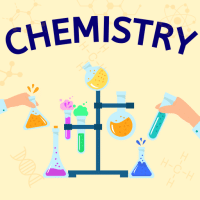Class 12 Exam > Class 12 Questions > If glyoxal glycol is treated with a mixture o...
Start Learning for Free
If glyoxal glycol is treated with a mixture of CH3MgBr and C2H5MgBr in diethyl ether followed by acid hydrolysis, how many different diols would be formed, which are simultaneously optically active?
Correct answer is '8'. Can you explain this answer?
Verified Answer
If glyoxal glycol is treated with a mixture of CH3MgBr and C2H5MgBr in...
One pair of enantiomers for each (I) and (II) while two pairs of enantiomers for (III).
Most Upvoted Answer
If glyoxal glycol is treated with a mixture of CH3MgBr and C2H5MgBr in...
Glyoxal glycol and Grignard reagents
When glyoxal glycol (also known as glycolaldehyde) is treated with a mixture of CH3MgBr and C2H5MgBr in diethyl ether, followed by acid hydrolysis, several diols can be formed. These diols are simultaneously optically active, meaning they have different optical isomers. Let's break down the reaction and explain the formation of these diols.
Formation of Grignard reagents
1. CH3MgBr (methylmagnesium bromide) and C2H5MgBr (ethylmagnesium bromide) are Grignard reagents that are prepared by reacting magnesium with methyl bromide (CH3Br) and ethyl bromide (C2H5Br), respectively.
2. The reaction takes place in diethyl ether as the solvent, which provides a suitable medium for the formation of Grignard reagents.
Addition of Grignard reagents to glyoxal glycol
1. The Grignard reagents, CH3MgBr and C2H5MgBr, act as nucleophiles and attack the electrophilic carbonyl carbon of glyoxal glycol.
2. This results in the formation of two different alcohols, one with a methyl group and the other with an ethyl group attached to the carbon adjacent to the carbonyl group of glyoxal glycol.
3. The reaction can occur twice, once with CH3MgBr and once with C2H5MgBr, resulting in four different alcohols.
Acid hydrolysis
1. After the addition of Grignard reagents, the resulting alcohols undergo acid hydrolysis.
2. Acid hydrolysis involves the addition of an acid, such as dilute hydrochloric acid, to the reaction mixture.
3. Acid hydrolysis breaks the carbon-magnesium bond and converts the alcohols back into carbonyl compounds.
4. In this case, the carbonyl compounds formed are glyoxal and glycolaldehyde, which are the starting materials for the reaction.
Formation of diols
1. The reaction between glyoxal and glycolaldehyde can result in the formation of diols through a series of reactions.
2. The reaction can involve the addition of glycolaldehyde to glyoxal, followed by the addition of glyoxal to glycolaldehyde.
3. This process can occur twice for each starting material, resulting in four different diols.
4. Additionally, each diol can exist as a pair of enantiomers, resulting in a total of eight different diols.
5. Enantiomers are mirror images of each other and possess opposite optical activities.
In summary
- When glyoxal glycol is treated with a mixture of CH3MgBr and C2H5MgBr in diethyl ether, followed by acid hydrolysis, a total of eight different diols are formed.
- The formation of these diols involves the addition of Grignard reagents to glyoxal glycol and subsequent acid hydrolysis.
- Each diol can exist as a pair of enantiomers, resulting in simultaneous
When glyoxal glycol (also known as glycolaldehyde) is treated with a mixture of CH3MgBr and C2H5MgBr in diethyl ether, followed by acid hydrolysis, several diols can be formed. These diols are simultaneously optically active, meaning they have different optical isomers. Let's break down the reaction and explain the formation of these diols.
Formation of Grignard reagents
1. CH3MgBr (methylmagnesium bromide) and C2H5MgBr (ethylmagnesium bromide) are Grignard reagents that are prepared by reacting magnesium with methyl bromide (CH3Br) and ethyl bromide (C2H5Br), respectively.
2. The reaction takes place in diethyl ether as the solvent, which provides a suitable medium for the formation of Grignard reagents.
Addition of Grignard reagents to glyoxal glycol
1. The Grignard reagents, CH3MgBr and C2H5MgBr, act as nucleophiles and attack the electrophilic carbonyl carbon of glyoxal glycol.
2. This results in the formation of two different alcohols, one with a methyl group and the other with an ethyl group attached to the carbon adjacent to the carbonyl group of glyoxal glycol.
3. The reaction can occur twice, once with CH3MgBr and once with C2H5MgBr, resulting in four different alcohols.
Acid hydrolysis
1. After the addition of Grignard reagents, the resulting alcohols undergo acid hydrolysis.
2. Acid hydrolysis involves the addition of an acid, such as dilute hydrochloric acid, to the reaction mixture.
3. Acid hydrolysis breaks the carbon-magnesium bond and converts the alcohols back into carbonyl compounds.
4. In this case, the carbonyl compounds formed are glyoxal and glycolaldehyde, which are the starting materials for the reaction.
Formation of diols
1. The reaction between glyoxal and glycolaldehyde can result in the formation of diols through a series of reactions.
2. The reaction can involve the addition of glycolaldehyde to glyoxal, followed by the addition of glyoxal to glycolaldehyde.
3. This process can occur twice for each starting material, resulting in four different diols.
4. Additionally, each diol can exist as a pair of enantiomers, resulting in a total of eight different diols.
5. Enantiomers are mirror images of each other and possess opposite optical activities.
In summary
- When glyoxal glycol is treated with a mixture of CH3MgBr and C2H5MgBr in diethyl ether, followed by acid hydrolysis, a total of eight different diols are formed.
- The formation of these diols involves the addition of Grignard reagents to glyoxal glycol and subsequent acid hydrolysis.
- Each diol can exist as a pair of enantiomers, resulting in simultaneous

|
Explore Courses for Class 12 exam
|

|
Question Description
If glyoxal glycol is treated with a mixture of CH3MgBr and C2H5MgBr in diethyl ether followed by acid hydrolysis, how many different diols would be formed, which are simultaneously optically active?Correct answer is '8'. Can you explain this answer? for Class 12 2025 is part of Class 12 preparation. The Question and answers have been prepared according to the Class 12 exam syllabus. Information about If glyoxal glycol is treated with a mixture of CH3MgBr and C2H5MgBr in diethyl ether followed by acid hydrolysis, how many different diols would be formed, which are simultaneously optically active?Correct answer is '8'. Can you explain this answer? covers all topics & solutions for Class 12 2025 Exam. Find important definitions, questions, meanings, examples, exercises and tests below for If glyoxal glycol is treated with a mixture of CH3MgBr and C2H5MgBr in diethyl ether followed by acid hydrolysis, how many different diols would be formed, which are simultaneously optically active?Correct answer is '8'. Can you explain this answer?.
If glyoxal glycol is treated with a mixture of CH3MgBr and C2H5MgBr in diethyl ether followed by acid hydrolysis, how many different diols would be formed, which are simultaneously optically active?Correct answer is '8'. Can you explain this answer? for Class 12 2025 is part of Class 12 preparation. The Question and answers have been prepared according to the Class 12 exam syllabus. Information about If glyoxal glycol is treated with a mixture of CH3MgBr and C2H5MgBr in diethyl ether followed by acid hydrolysis, how many different diols would be formed, which are simultaneously optically active?Correct answer is '8'. Can you explain this answer? covers all topics & solutions for Class 12 2025 Exam. Find important definitions, questions, meanings, examples, exercises and tests below for If glyoxal glycol is treated with a mixture of CH3MgBr and C2H5MgBr in diethyl ether followed by acid hydrolysis, how many different diols would be formed, which are simultaneously optically active?Correct answer is '8'. Can you explain this answer?.
Solutions for If glyoxal glycol is treated with a mixture of CH3MgBr and C2H5MgBr in diethyl ether followed by acid hydrolysis, how many different diols would be formed, which are simultaneously optically active?Correct answer is '8'. Can you explain this answer? in English & in Hindi are available as part of our courses for Class 12.
Download more important topics, notes, lectures and mock test series for Class 12 Exam by signing up for free.
Here you can find the meaning of If glyoxal glycol is treated with a mixture of CH3MgBr and C2H5MgBr in diethyl ether followed by acid hydrolysis, how many different diols would be formed, which are simultaneously optically active?Correct answer is '8'. Can you explain this answer? defined & explained in the simplest way possible. Besides giving the explanation of
If glyoxal glycol is treated with a mixture of CH3MgBr and C2H5MgBr in diethyl ether followed by acid hydrolysis, how many different diols would be formed, which are simultaneously optically active?Correct answer is '8'. Can you explain this answer?, a detailed solution for If glyoxal glycol is treated with a mixture of CH3MgBr and C2H5MgBr in diethyl ether followed by acid hydrolysis, how many different diols would be formed, which are simultaneously optically active?Correct answer is '8'. Can you explain this answer? has been provided alongside types of If glyoxal glycol is treated with a mixture of CH3MgBr and C2H5MgBr in diethyl ether followed by acid hydrolysis, how many different diols would be formed, which are simultaneously optically active?Correct answer is '8'. Can you explain this answer? theory, EduRev gives you an
ample number of questions to practice If glyoxal glycol is treated with a mixture of CH3MgBr and C2H5MgBr in diethyl ether followed by acid hydrolysis, how many different diols would be formed, which are simultaneously optically active?Correct answer is '8'. Can you explain this answer? tests, examples and also practice Class 12 tests.

|
Explore Courses for Class 12 exam
|

|
Signup for Free!
Signup to see your scores go up within 7 days! Learn & Practice with 1000+ FREE Notes, Videos & Tests.


















